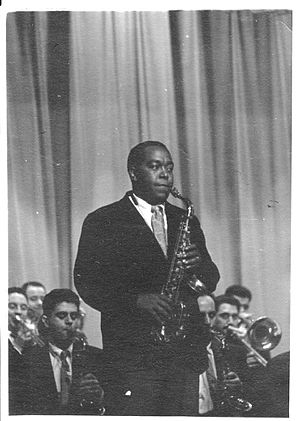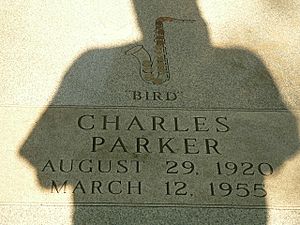Charlie Parker facts for kids
Quick facts for kids
Charlie Parker
|
|
|---|---|
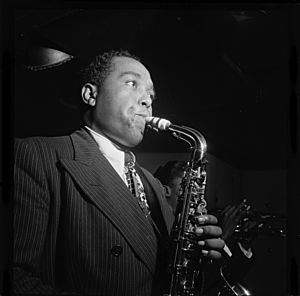
Parker at the Three Deuces jazz club, New York, 1947
|
|
| Background information | |
| Birth name | Charles Parker Jr. |
| Also known as | Bird, Yardbird |
| Born | August 29, 1920 Kansas City, Kansas, U.S. |
| Died | March 12, 1955 (aged 34) New York City, U.S. |
| Genres | |
| Occupation(s) |
|
| Instruments | Alto and tenor saxophone |
| Years active | 1937–1955 |
| Labels | |
| Associated acts |
|
Charles Parker Jr. (born August 29, 1920 – died March 12, 1955) was an American jazz saxophonist, band leader, and composer. People often called him "Bird" or "Yardbird". Parker was a super important musician and a main leader in creating bebop, a fast and exciting style of jazz.
Bebop jazz uses quick tempos, amazing playing skills, and complex musical ideas. Parker was an incredibly talented player. He brought many new and exciting musical ideas to jazz. These included fast chord changes and different ways to use chords. He mostly played the alto saxophone. His sound could be clear and strong, or soft and sad.
He got the nickname "Yardbird" early in his career. This name, and the shorter "Bird," stuck with him his whole life. It even inspired the names of some of his songs. These include "Yardbird Suite", "Ornithology", and "Bird Gets the Worm".
Contents
Biography of Charlie Parker
Early Life and Music
Charlie Parker Jr. was born in Kansas City, Kansas. He grew up in Kansas City, Missouri. He started playing the saxophone when he was 11 years old. At 14, he joined his high school band. His mother bought him a new alto saxophone around this time.
His father was a pianist, dancer, and singer. He traveled a lot for work. Charlie's mother worked nights at Western Union. A young trombone player named Robert Simpson taught Charlie the basics of how to improvise music.
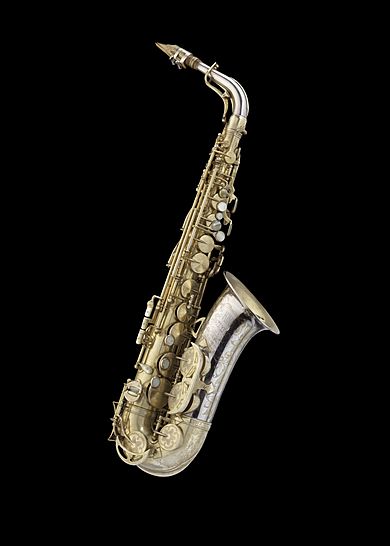
Starting His Career
In the mid-1930s, Parker started practicing a lot. He practiced up to 15 hours a day for several years. During this time, he became very good at improvising. He also started to develop the ideas that would become bebop.
He played with local bands in jazz clubs in Kansas City. He improved his skills with help from Buster Smith. Smith's way of changing tempos influenced Parker's style. In 1936, Parker had a tough moment at a jam session. He lost track of the music. The drummer, Jo Jones, threw a cymbal at his feet. This meant for him to leave the stage. Instead of giving up, Parker promised to practice even harder. This moment was a turning point for him.
In 1938, Parker joined pianist Jay McShann's band. The band toured clubs in the southwest, Chicago, and New York City. Parker made his first professional recordings with McShann's band.
Moving to New York City
In 1939, Parker moved to New York City to focus on music. He also worked other jobs, like washing dishes. It was in New York in 1939 that he had a big musical breakthrough. He was playing the song "Cherokee." He discovered a new way to play solos. This changed music history.
In 1942, Parker left McShann's band. He played with Earl Hines for a year. Dizzy Gillespie was also in Hines's band. Parker and Gillespie later played together often. Many young musicians joined Parker in Harlem clubs. They wanted to create new music that others couldn't easily copy.
The Rise of Bebop Jazz
One night in 1939, Parker was practicing "Cherokee." He realized that all 12 notes of the musical scale could lead to any key. This gave him more freedom to create solos. He said he was bored with the old ways of playing. He found that by using higher notes in a chord as a melody, he could play the music he heard in his head. This made him feel "alive."
At first, many older jazz musicians didn't like this new style. They called the bebop players "moldy figs." But some famous musicians, like Coleman Hawkins, liked it. They joined in jam sessions and recordings.
There was a ban on commercial recordings from 1942 to 1944. This meant much of bebop's early growth was not recorded. So, it wasn't heard much on the radio. Bebop musicians had a hard time getting famous. But in 1945, the ban was lifted. Parker's recordings with Dizzy Gillespie, Max Roach, and Miles Davis changed the jazz world. Bebop quickly became popular with musicians and fans.
On November 26, 1945, Parker led a recording session for the Savoy label. It was called the "greatest Jazz session ever." Parker's band included Gillespie and Davis. They recorded famous songs like "Ko-Ko" and "Billie's Bounce".
'Charlie Parker with Strings'
Charlie Parker always wanted to play with a string section. He loved classical music. He was very interested in the music of Igor Stravinsky. He wanted to mix jazz and classical music.
In 1949, Norman Granz helped Parker record an album of ballads. He played with jazz and classical musicians. Six songs from this session became the album Charlie Parker with Strings. These included "Just Friends" and "Summertime".
'Jazz at Massey Hall'
In 1953, Parker played a concert at Massey Hall in Toronto. He was joined by Gillespie, Charles Mingus, Bud Powell, and Max Roach. Not many people came to the concert. This was because a big boxing match was on TV at the same time. Mingus recorded the concert. This recording became the album Jazz at Massey Hall. At this concert, Parker played a plastic saxophone.
His Final Years
Charlie Parker passed away on March 12, 1955, in New York City. He was only 34 years old. The official causes of death were pneumonia and a bleeding ulcer. He also had other health problems. The doctor who checked his body thought he looked much older, between 50 and 60 years old.
Dizzy Gillespie helped pay for Parker's funeral. He also organized a memorial concert. Parker was buried in Lincoln Cemetery in Missouri.
Parker's Musical Style
Parker often created new songs by using the chord patterns of old jazz songs. This is called "contrafact." It is still common in jazz today. For example, "Ornithology" uses the chords from "How High the Moon". "Moose the Mooche" uses the chords from "I Got Rhythm". This became a special part of the bebop style.
Some of his songs, like "Now's The Time" and "Billie's Bounce", used common 12-bar blues patterns. But Parker also made his own unique blues chords. These are known as "Bird Changes". His solos and songs often had long, complex melodies. They didn't repeat much.
Parker greatly influenced how jazz solos are played today. He used musical notes in new ways. This gave soloists more freedom. People loved his unique way of playing and his new rhythms. His recordings and the Charlie Parker Omnibook helped his style become very popular.
Other well-known Parker songs include "Confirmation" and "Yardbird Suite".
Miles Davis once said, "You can tell the history of jazz in four words: Louis Armstrong. Charlie Parker."
Awards and Recognition
Grammy Awards
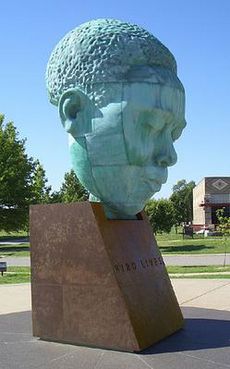
Charlie Parker won a Grammy Award in 1974 for First Recordings!.
His recordings were also added to the Grammy Hall of Fame. This award honors recordings that are at least 25 years old and have special historical importance.
- "Billie's Bounce" (recorded 1945) was inducted in 2002.
- Jazz at Massey Hall (recorded 1953) was inducted in 1995.
- "Ornithology" (recorded 1946) was inducted in 1989.
- Charlie Parker with Strings (recorded 1950) was inducted in 1988.
Other Honors
- In 2004, he was inducted into the Nesuhi Ertegun Jazz Hall of Fame.
- He received a Grammy Lifetime Achievement Award in 1984.
- He was inducted into the Big Band and Jazz Hall of Fame in 1979.
Government Honors
- In 1995, the United States Postal Service made a special postage stamp to honor Parker.
- In 2002, the Library of Congress added his recording "Ko-Ko" (1945) to the National Recording Registry. This registry saves important American sound recordings.
Charlie Parker's Home
|
Charlie Parker Residence
|
|
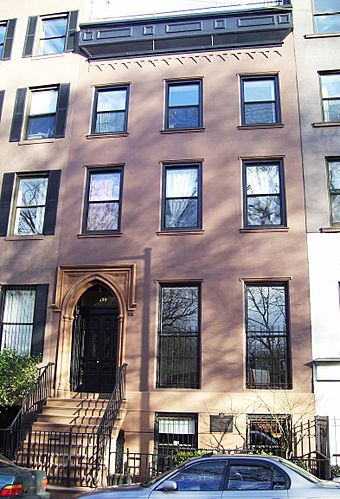
151 Avenue B in 2011
|
|
| Location | 151 Avenue B Manhattan, New York City |
|---|---|
| Built | circa 1849 |
| Architectural style | Gothic Revival |
| NRHP reference No. | 94000262 |
| Significant dates | |
| Added to NRHP | April 7, 1994 |
| Designated NRHP | April 7, 1994 |
From 1950 to 1954, Parker lived in a townhouse at 151 Avenue B in New York City. This building was added to the National Register of Historic Places in 1994. It was also named a New York City landmark in 1999. In 1992, Avenue B between East 7th and East 10th Streets was named "Charlie Parker Place" in his honor.
Tributes to Charlie Parker
Musical Tributes
- The famous jazz fusion song "Birdland" by Weather Report (1977) was named for Charlie Parker.
- The British band The Yardbirds was partly inspired by Parker's nickname.
- The opera Charlie Parker's Yardbird was first performed in 2015.
- Charles Mingus wrote the song "Reincarnation of a Lovebird" for him.
Other Tributes
- In 1949, the New York jazz club Birdland was named after him.
- George Shearing wrote "Lullaby of Birdland" (1952) for Parker and the club.
- A 10-foot tall bronze sculpture of Parker's head was put in Kansas City in 1999.
- The Charlie Parker Jazz Festival is a free music festival held every summer in New York City.
- The Annual Charlie Parker Celebration is a festival held every year in Kansas City, Kansas. It celebrates his life and music.
- In 1981, a radio show called Bird Flight started. It plays only Parker's music.
- The 1988 movie Bird, directed by Clint Eastwood, tells Parker's life story.
- Charlie Watts, the drummer for the Rolling Stones, wrote a children's book about Parker called Ode to a High Flying Bird.
Discography
Images for kids
-
Parker with (from left to right) Tommy Potter, Max Roach, Miles Davis, and Duke Jordan, at the Three Deuces, New York, circa 1945
See also
 In Spanish: Charlie Parker para niños
In Spanish: Charlie Parker para niños


